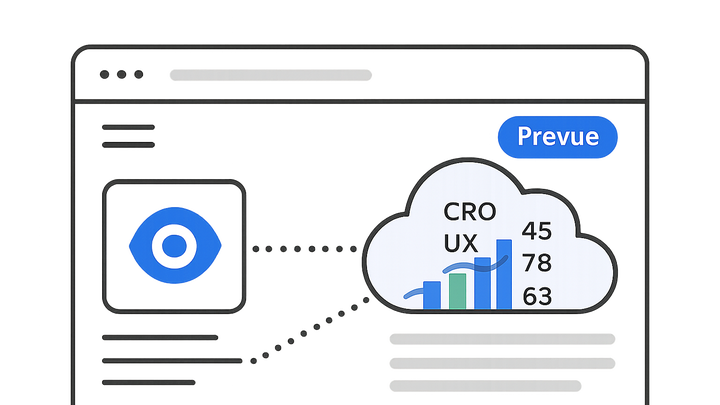Published on 2025-06-29T19:20:24Z
What is Pixel Tracking? How It Boosts CRO, UX, and SEO
Pixel tracking refers to the practice of embedding tiny, often transparent, code snippets or images (pixels) into web pages or emails to capture and relay user interaction data back to analytics or marketing platforms. In the context of website critiques focused on Conversion Rate Optimization (CRO), User Experience (UX), and Search Engine Optimization (SEO), pixel tracking provides granular insights into how real users navigate, engage, and convert on a site. By recording events such as page views, clicks, form submissions, and scroll depth, businesses can identify friction points, optimize layouts, and refine content strategies. Tools like Prevue.me leverage pixel tracking to generate automated, actionable critiques that help maximize lead generation, improve accessibility, and strengthen SEO performance. When implemented thoughtfully—balancing performance, privacy, and compliance—pixel tracking becomes a powerful ally in crafting data-driven website enhancements.
Pixel tracking
Capturing user interactions via tiny snippets to inform and optimize CRO, UX, and SEO strategies.
Understanding Pixel Tracking
Dive into the fundamentals of pixel tracking, the technology behind these tiny code snippets, and how they function to capture critical user data on your website.
-
Pixel basics
A tracking pixel is a 1x1 transparent image or JavaScript snippet that loads when a user views a page or performs an action, sending data to a server for analysis.
- 1x1 transparent image:
A tiny GIF or PNG embedded in HTML or CSS, invisible to users, that triggers a server call when loaded.
- Javascript pixel:
A script-based approach that can capture richer event data, user attributes, and support dynamic triggers.
- 1x1 transparent image:
-
Types of pixels
Different pixels serve unique purposes, from basic pageview tracking to conversion measurement and audience retargeting.
- Pageview pixel:
Records each time a page loads, helping measure traffic, session count, and navigation paths.
- Conversion pixel:
Fires on key actions like sign-ups or purchases, enabling precise measurement of goal completions.
- Retargeting pixel:
Drops a cookie on the visitor’s browser to build audiences for personalized ad campaigns.
- Pageview pixel:
-
Integration with tag managers
Pixels are often deployed via tag management systems for streamlined updates, version control, and performance optimization.
- Google tag manager:
A popular platform for adding, updating, and testing pixels without direct code changes to your site.
- Server-side containers:
Processes pixel events on the server to boost performance, enhance security, and better manage data privacy.
- Google tag manager:
Benefits for CRO, UX, and SEO
Discover how pixel tracking fuels data-driven improvements across conversion optimization, user experience design, and search engine strategies by revealing real user behaviors.
-
Optimizing conversion rates
Pixel data highlights where users drop off in funnels and uncovers behavior patterns that, when addressed, increase sign-ups and sales.
- Funnel drop-off analysis:
Identifies specific steps in conversion paths where visitors abandon, guiding targeted optimizations.
- Behavioral segmentation:
Groups users by actions or demographics to tailor messaging, design, and personalization efforts.
- Funnel drop-off analysis:
-
Enhancing user experience
Tracking clicks, scrolls, and interaction heatmaps empowers UX teams to refine layouts, content placement, and navigation flows.
- Heatmaps:
Visual representations of where users click, move, or scroll most frequently on a page.
- Session recordings:
Replays individual user sessions to uncover navigation challenges, confusion points, and UX friction.
- Heatmaps:
-
Informing seo strategy
Interaction metrics like scroll depth and bounce rate offer SEO teams insight into content relevance and user engagement quality.
- Scroll depth tracking:
Measures how far users scroll to evaluate content engagement and identify opportunities for stronger calls to action.
- Bounce rate monitoring:
Tracks single-page sessions to pinpoint landing page improvements for lower bounce rates and higher dwell time.
- Scroll depth tracking:
Implementing Pixel Tracking with Prevue.me
Learn how to integrate prevue.me’s pixel into your site to harness automated critiques for CRO, SEO, UX, and accessibility improvements.
-
Setup guide
Follow a simple process to install prevue.me’s tracking code and start collecting user interaction data immediately.
- Install tracking snippet:
Copy the JavaScript snippet from prevue.me’s dashboard into the <head> section of your site.
- Verify deployment:
Use browser network tools or prevue.me’s real-time validation feature to confirm data transmission.
- Install tracking snippet:
-
Actionable critiques
prevue.me analyzes pixel data to provide targeted recommendations that improve lead generation, accessibility, and overall site performance.
- Lead generation insights:
Highlights form placement and CTA tweaks to boost conversion rates and capture more qualified leads.
- Accessibility feedback:
Flags missing ARIA attributes, color contrast issues, and other barriers affecting users with disabilities.
- Lead generation insights:
Best Practices and Privacy Considerations
Balance robust data collection with site performance and user privacy by following proven guidelines and compliance standards.
-
Performance optimization
Ensure tracking pixels have minimal impact on page load times and overall user experience.
- Asynchronous loading:
Load pixels without blocking the main thread to maintain fast rendering.
- Batch requests:
Group multiple tracking events into single network calls to reduce overhead.
- Asynchronous loading:
-
Privacy and compliance
Adhere to regulations such as GDPR, CCPA, and other privacy laws by managing user consent and transparent data practices.
- Cookie consent banners:
Display clear consent notices before firing tracking pixels, allowing users to opt in or out.
- Data retention policies:
Define and communicate retention periods and purposes for stored tracking data.
- Cookie consent banners:
